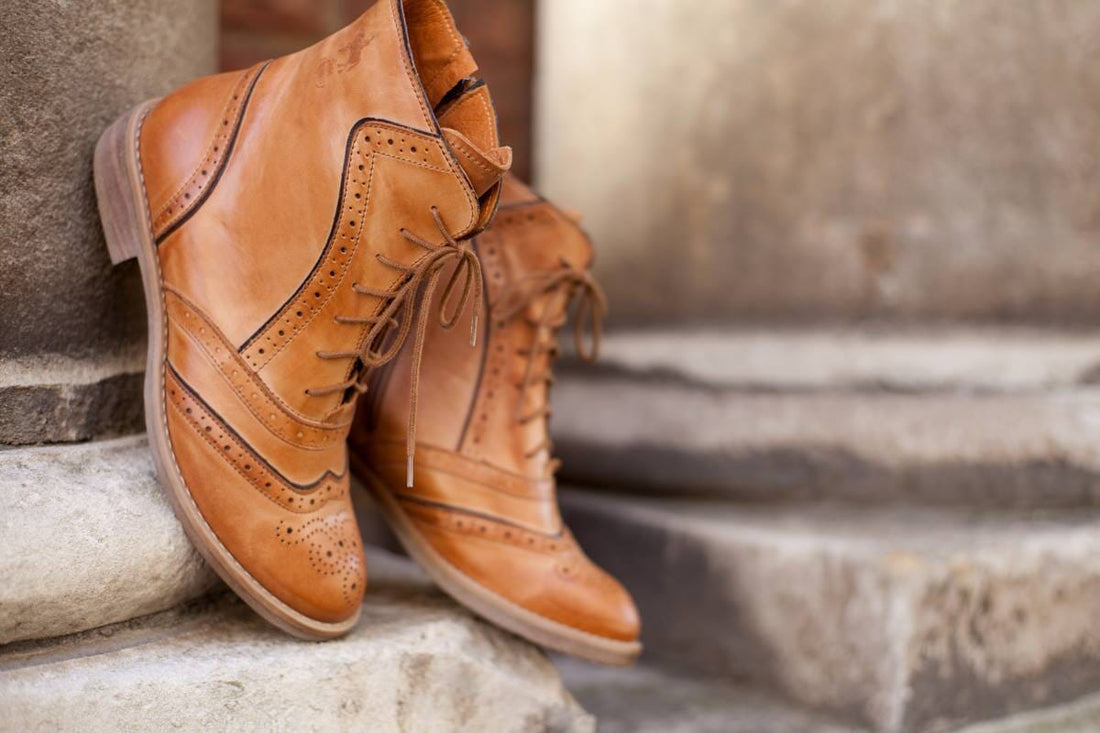Brogue, from the Gaelic word bróg which initially referred to shoes in general, now refers to any low-heeled shoe, loafer, or boot with hole perforations on the leather uppers (top of the shoe), known as broguing. There are many types of brogue designs, including wingtips or full brogues, semi-brogues, and quarter brogues, which all feature different decorative perforations and serrated edges. Let’s learn all about brogues!
A Brief History of Brogues
Brogues were invented around the 19th century for Irish and Scottish folks who worked in the muddy countryside. They were made from durable, untanned cowhide with perforations that worked as a drainage system, allowing water to evacuate the shoe. They were laced by leather tangs without a tongue, which kept the laces free from muck and prevented them from being sucked off while walking in the mud. This design is now known as the ghillie brogue and is often considered the standard style for traditional Scottish dress footwear.
Originally designed for outdoor wear by the working class, over time they were adopted by country gentlemen as an outdoor country walking shoe. By the 1920s, brogues had evolved for more formal usage and also rose to popularity in the United States, where two-toned brogues known as spectator shoes became a popular choice for many in the Jazz scene. By the twentieth century, the brogue was also used as a template for fashionable women’s footwear.
Many types of shoes can be found with broguing which is where things can get confusing when we hear something like oxfords are not always brogues, and brogues are not always oxfords...an oxford is a dress shoe that has a closed lacing system, meaning the parts of the shoe that hold the shoelace eyelets are sewn under the vamp, rather than on top of it. Shoes with an open lace (a derby) can never be an oxford and a shoe without perforations can never be a brogue.
Different Styles of Brogues
We’ve learned the lacing system (“derby” open vs “oxford” closed lacing and “monk strap” buckled) and the absence or presence of broguing ornamentation are the determining features in different styles of shoes. Any shoe with broguing is called a brogue, even if it’s an oxford and there are different types of brogue styling. Quarter brogues are the simplest with perforations only on the upper edge of the toe cap; there’s no medallion or any other broguing on the shoe.
Semi brogues have perforation only on the toe cap, while quarter brogues include perforations and serrations only along the edge of the toe cap. These styles are the middle ground between dressy and relaxed, they’re conventional and striking, without being as whimsical as their fully brogued counterparts. A general rule of thumb is that a shoe is less formal the more broguing it has and vice versa. Therefore a full brogue or wingtip is considered the most casual type of brogue shoe.
A wingtip has a toe cap with wings which resemble a W-shape that extend along the sides of the shoe. A shoe with a wingtip but no perforations is known as an austerity “brogue” while a plain shoe with brogue style perforations is known as a blind brogue. A U-Cap or U-Tip brogue is an adaptation of a wingtip where the cap is u-shaped rather than pointed, and wraps around the vamp of the shoe while longwing brogues have the wings wrap around the full length of the shoe and meet at a center seam at the heel.
Here at Embassy London we love all things brogue, and you’ll find a wide selection of shoes and boots for both men and women with different brogue styles. Whether you want a pop of color or a timeless shoe we have a brogue for you!

